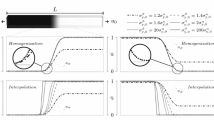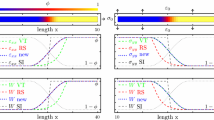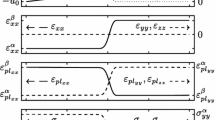Abstract
Computational models based on the phase-field method have become an essential tool in material science and physics in order to investigate materials with complex microstructures. The models typically operate on a mesoscopic length scale resolving structural changes of the material and provide valuable information about the evolution of microstructures and mechanical property relations. For many interesting and important phenomena, such as martensitic phase transformation, mechanical driving forces play an important role in the evolution of microstructures. In order to investigate such physical processes, an accurate calculation of the stresses and the strain energy in the transition region is indispensable. We recall a multiphase-field elasticity model based on the force balance and the Hadamard jump condition at the interface. We show the quantitative characteristics of the model by comparing the stresses, strains and configurational forces with theoretical predictions in two-phase cases and with results from sharp interface calculations in a multiphase case. As an application, we choose the martensitic phase transformation process in multigrain systems and demonstrate the influence of the local homogenization scheme within the transition regions on the resulting microstructures.








Similar content being viewed by others
Change history
07 December 2017
In the original publication, equation 52 was published incorrectly.
References
Chen LQ (2002) Phase-field models for microstructure evolution. Ann Rev Mater Res 32(1):113. https://doi.org/10.1146/annurev.matsci.32.112001.132041
Moelans N, Blanpain B, Wollants P (2008) An introduction to phase-field modeling of microstructure evolution. Calphad 32(2):268. https://doi.org/10.1016/j.calphad.2007.11.003
van der Waals JD (1894) Thermodynamische Theorie der Kapillarität unter voraussetzung stetiger Dichteänderung. Z Phys Chem Leipzig 13:657
Ginzburg VL, Landau LD (1950) On the theory of superconductivity. Zh Eksp Teor Fiz 20:1064
Cahn JW, Hilliard JE (1958) Free energy of a nonuniform system. I. interfacial free energy. The J Chem Phys 28(2):258. https://doi.org/10.1063/1.1744102
Halperin B, Hohenberg P, Ma S (1974) Renormalization-group methods for critical dynamics: I. Recur Relat Eff Energy Conserv Phys Rev B 10(1):139. https://doi.org/10.1103/PhysRevB.10.139
Steinbach I (2013) Phase-field model for microstructure evolution at the mesoscopic scale. Ann Rev Mater Res 43(1):89. https://doi.org/10.1146/annurev-matsci-071312-121703
Nestler B, Choudhury A (2011) Phase-field modeling of multi-component systems. Curr Opin Solid State and Mater Sci 15(3):93. https://doi.org/10.1016/j.cossms.2011.01.003
Ammar K, Appolaire B, Cailletaud G, Forest S (2009) Combining phase field approach and homogenization methods for modelling phase transformation in elastoplastic media. Revue européenne de mécanique numérique 18(5–6):485. https://doi.org/10.3166/ejcm.18.485-523
Khachaturyan AG (1983) Theory of structural transformation in solids. John Wiley & Sons Inc, Hoboken
Voigt W (1889) Über die Beziehung zwischen den beiden Elastizitätskonstanten isotroper Körper. Annalen der Physik 274(12):573
Spatschek R, Müller-Gugenberger C, Brener E, Nestler B (2007) Phase field modeling of fracture and stress-induced phase transitions. Phys Rev E 75(6):066111. https://doi.org/10.1103/PhysRevE.75.066111
Mennerich C, Wendler F, Jainta M, Nestler B (2011) A phase-field model for the magnetic shape memory effect. Arch Mech 63:549
Schneider D, Selzer M, Bette J, Rementeria I, Vondrous A, Hoffmann MJ, Nestler B (2014) Phase-field modeling of diffusion coupled crack propagation processes. Adv Eng Mater 16(2):142. https://doi.org/10.1002/adem.201300073
Schneider D, Schmid S, Selzer M, Böhlke T, Nestler B (2015) Small strain elasto-plastic multiphase-field model. Comput Mech 55(1):27. https://doi.org/10.1007/s00466-014-1080-7
Schneider D, Schoof E, Huang Y, Selzer M, Nestler B (2016) Phase-field modeling of crack propagation in multiphase systems. Comput Methods in Appl Mech Eng 312:186–195. https://doi.org/10.1016/j.cma.2016.04.009
Levitas VI (2013) Thermodynamically consistent phase field approach to phase transformations with interface stresses. Acta Mater 61(12):4305. https://doi.org/10.1016/j.actamat.2013.03.034
Reuss A (1929) Berechnung der Fließgrenze von Mischkristallen auf Grund der Plastizittitsbedingung fiir Einkristalle. Z Angew Math Mech 9:49
Steinbach I, Apel M (2006) Multi phase field model for solid state transformation with elastic strain. Phys D 217:153. https://doi.org/10.1016/j.physd.2006.04.001
Apel M, Benke S, Steinbach I (2009) Virtual dilatometer curves and effective Young’s modulus of a 3D multiphase structure calculated by the phase-field method. Comput Mater Sci 45(3):589. https://doi.org/10.1016/j.commatsci.2008.07.007
Durga A, Wollants P, Moelans N (2013) Evaluation of interfacial excess contributions in different phase-field models for elastically inhomogeneous systems. Modell Simul Mater Sci Eng 21(5):055018. https://doi.org/10.1088/0965-0393/21/5/055018
Schneider D, Tschukin O, Choudhury A, Selzer M, Böhlke T, Nestler B (2015) Phase-field elasticity model based on mechanical jump conditions. Comput Mech 55(5):887. https://doi.org/10.1007/s00466-015-1141-6
Schneider D (2017) Phasenfeldmodellierung mechanisch getriebener Grenzflächenbewegungen in mehrphasigen Systemen. Ph.D. thesis
Mosler J, Shchyglo O, Hojjat HM (2014) A novel homogenization method for phase field approaches based on partial rank-one relaxation. J Mech Phys Solids 68:251. https://doi.org/10.1016/j.jmps.2014.04.002
Schneider D, Schwab F, Schoof E, Reiter A, Herrmann C, Selzer M, Böhlke T, Nestler B (2017) On the stress calculation within phase-field approaches: a model for finite deformations. Comput Mech (in press). https://doi.org/10.1007/s00466-017-1401-8
Nestler B, Garcke H, Stinner B (2005) Multicomponent alloy solidification: phase-field modeling and simulations. Phys Rev E 71(4):041609. https://doi.org/10.1103/PhysRevE.71.041609
Provatas N, Elder K (2010) Phase-field methods in materials science and engineering. Wiley-VCH Verlag, Weinheim. https://doi.org/10.1002/9783527631520
Nestler B (2000) Phasenfeldmodellierung mehrphasiger Erstarrung. Ph.D. thesis
Hötzer J, Tschukin O, Ben Said M, Berghoff M, Jainta M, Barthelemy G, Smorchkov N, Schneider D, Selzer M, Nestler B (2016) Calibration of a multi-phase field model with quantitative angle measurement. J Mater Sci 51(4):1788. https://doi.org/10.1007/s10853-015-9542-7
Moelans N (2011) A quantitative and thermodynamically consistent phase-field interpolation function for multi-phase systems. Acta Mater 59(3):1077. https://doi.org/10.1016/j.actamat.2010.038
Steinbach I, Pezzolla F (1999) A generalized field method for multiphase transformations using interface fields. Phys D: Nonlinear Phenom 134(4):385. https://doi.org/10.1016/S0167-2789(99)00129-3
Eshelby JD (1951) The force on an elastic singularity. Philosophical transactions of the royal society. A: Math Phys Eng Sci 244(877):87–112. https://doi.org/10.1098/rsta.1951.0016
Eshelby JD (1975) The elastic energy-momentum tensor. J Elast 5(3–4):321. https://doi.org/10.1007/BF00126994
Gurtin ME (1983) Two-phase deformations of elastic solids. Arch Ration Mech Anal 84(1):1–29. https://doi.org/10.1007/BF00251547
Gurtin ME (1995) The nature of configurational forces. Arch Ration Mech Anal 131(1):67. https://doi.org/10.1007/BF00386071
James RD (1981) Finite deformation by mechanical twinning. Arch Ration Mech Anal 77(2):143–176. https://doi.org/10.1007/BF00250621
Johnson WC (1987) Precipitate shape evolution under applied stress thermodynamics and kinetics. Metall Trans A 18A:233
Silhavy M (1997) The Mechanics and thermodynamics of continuous media. Springer Verlag, Berlin
Voorhees PW, Johnson WC (1986) Interfacial equilibrium during a first-order phase transformation in solids. The J Chem Phys 84(9):5108. https://doi.org/10.1063/1.450664
Gurtin ME (2000) Configurational forces as basic concepts of continuum physics. Springer, Berlin
Garcke H, Stoth B, Nestler B (1999) Anisotropy in multi-phase systems: a phase field approach. Interfaces and Free Bound 1(2):175–198. https://doi.org/10.4171/IFB/8
Johnson WC, Alexander JID (1986) Interfacial conditions for thermomechanical equilibrium in two-phase crystals. J Appl Phys 59(8):2735. https://doi.org/10.1063/1.336982
Mai AK, Singh SJ (1991) Deformation of elastic solids. Prentice-Hall, Upper Saddle River
Wang Y, Khachaturyan AG (2006) Multi-scale phase field approach to martensitic transformations. Mater Sci Eng: A 438–440:55. https://doi.org/10.1016/j.msea.2006.04.123
Mamivand M, Zaeem MA, El Kadiri H (2013) A review on phase field modeling of martensitic phase transformation. Comput Mater Sci 77:304. https://doi.org/10.1016/j.commatsci.2013.04.059
Ueda M, Yasuda HY, Umakoshi Y (2003) Controlling factor for nucleation of martensite at grain boundary in Fe-Ni bicrystals. Acta Mater 51(4):1007. https://doi.org/10.1016/S1359-6454(02)00503-7
Rios PR, Guimarães JRC (2010) Microstructural path analysis of martensite burst. Mater Res 13(1):119. https://doi.org/10.1590/S1516-14392010000100023
Artemev A, Jin Y, Khachaturyan AG (2001) Three-dimensional phase field model of proper martensitic transformation. Acta Mater 49(7):1165. https://doi.org/10.1016/S1359-6454(01)00021-0
Krauss W, Pabi SK, Gleiter H (1989) On the mechanism of martensite nucleation. Acta Metall 37(1):25. https://doi.org/10.1016/0001-6160(89)90262-9
Heo TW, Chen LQ (2014) Phase-field modeling of displacive phase transformations in elastically anisotropic and inhomogeneous polycrystals. Acta Mater 76:68. https://doi.org/10.1016/j.actamat.2014.05.014
Schmidt I, Gross D (1997) The equilibrium shape of an elastically inhomogeneous inclusion. J Mech Phys Solids 45(9):1521. https://doi.org/10.1016/S0022-5096(97)00011-2
Kim SG, Kim DI, Kim WT, Park YB (2006) Computer simulations of two-dimensional and three-dimensional ideal grain growth. Phys Rev E 74:061605
B. Nestler, M. Reichert, M. Selzer (2008) Massive multi-phase-field simulations: methods to compute large grain system. In: proceedings of the 11th international conference on aluminium alloys pp. 1251–1255
Vondrous A, Bienger P, Schreijäg S, Selzer M, Schneider D, Nestler B, Helm D, Mönig R (2015) Combined crystal plasticity and phase-field method for recrystallization in a process chain of sheet metal production. Comput Mech 55(2):439. https://doi.org/10.1007/s00466-014-1115-0
Hötzer J, Jainta M, Steinmetz P, Nestler B, Dennstedt A, Genau A, Bauer M, Köstler H, Rüde U (2015) Large scale phase-field simulations of directional ternary eutectic solidification. Acta Mater 93:194. https://doi.org/10.1016/j.actamat.2015.03.051
Hötzer J, Steinmetz P, Jainta M, Schulz S, Kellner M, Nestler B, Genau A, Dennstedt A, Bauer M, Köstler H, Rüde U (2016) Phase-field simulations of spiral growth during directional ternary eutectic solidification. Acta Mater 106:249. https://doi.org/10.1016/j.actamat.2015.12.052
Steinmetz P, Yabansu YC, Hötzer J, Jainta M, Nestler B, Kalidindi SR (2016) Analytics for microstructure datasets produced by phase-field simulations. Acta Mater 103:192. https://doi.org/10.1016/j.actamat.2015.09.047
Steinmetz P, Hötzer J, Kellner M, Dennstedt A, Nestler B (2016) Large-scale phase-field simulations of ternary eutectic microstructure evolution. Comput Mater Sci 117:205. https://doi.org/10.1016/j.commatsci.2016.02.001
Bauer M, Rüde U, Hötzer J, Jainta M, Steinmetz P, Berghoff M, Schornbaum F, Godenschwager C, Köstler H, Nestler B (2015) Massively parallel phase-field simulations for ternary eutectic directional solidification. In: proceedings of the international conference for high performance computing pp. 1–12. https://doi.org/10.1145/2807591.2807662
Schmitt R, Kuhn C, Skorupski R, Smaga M, Eifler D, Müller R (2015) A combined phase field approach for martensitic transformations and damage. Arch Appl Mech 85(9–10):1459. https://doi.org/10.1007/s00419-014-0945-8
Acknowledgements
We thank the DFG for funding our investigations in the framework of the Research Training Group 1483 and the International Research Training Group 2078. The work was further supported by the state of Baden-Württemberg through the “Mittelbau” program and by the Helmholz program “EMR-Energy efficiency, Materials and Ressources”. The authors gratefully acknowledge the editorial support by Leon Geisen. The authors also thank the referees for their very useful comments.
Author information
Authors and Affiliations
Corresponding author
Additional information
The original version of this article was revised: In the original publication, the equation 52 was published incorrectly and is corrected now.
Rights and permissions
About this article
Cite this article
Schneider, D., Schoof, E., Tschukin, O. et al. Small strain multiphase-field model accounting for configurational forces and mechanical jump conditions. Comput Mech 61, 277–295 (2018). https://doi.org/10.1007/s00466-017-1458-4
Received:
Accepted:
Published:
Issue Date:
DOI: https://doi.org/10.1007/s00466-017-1458-4




